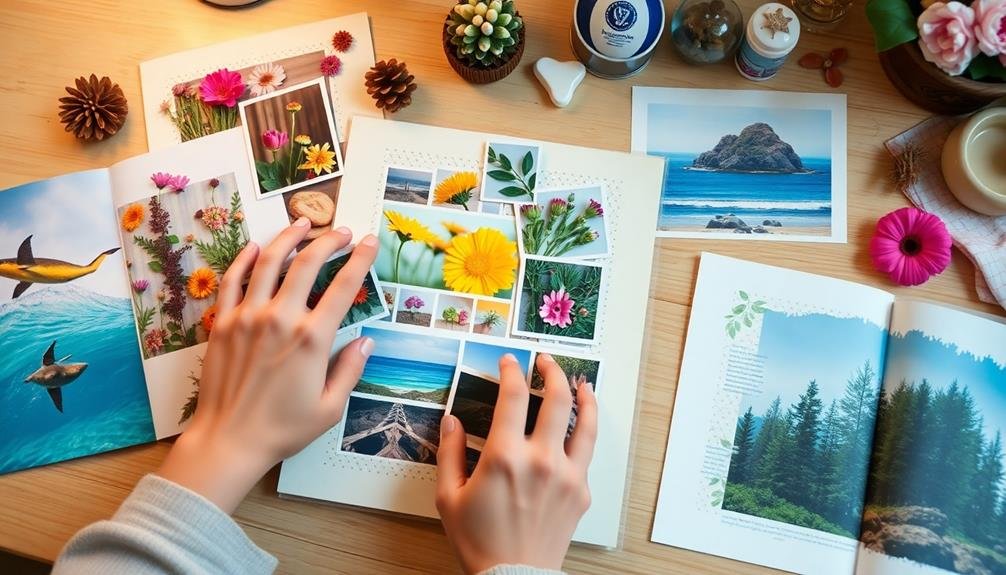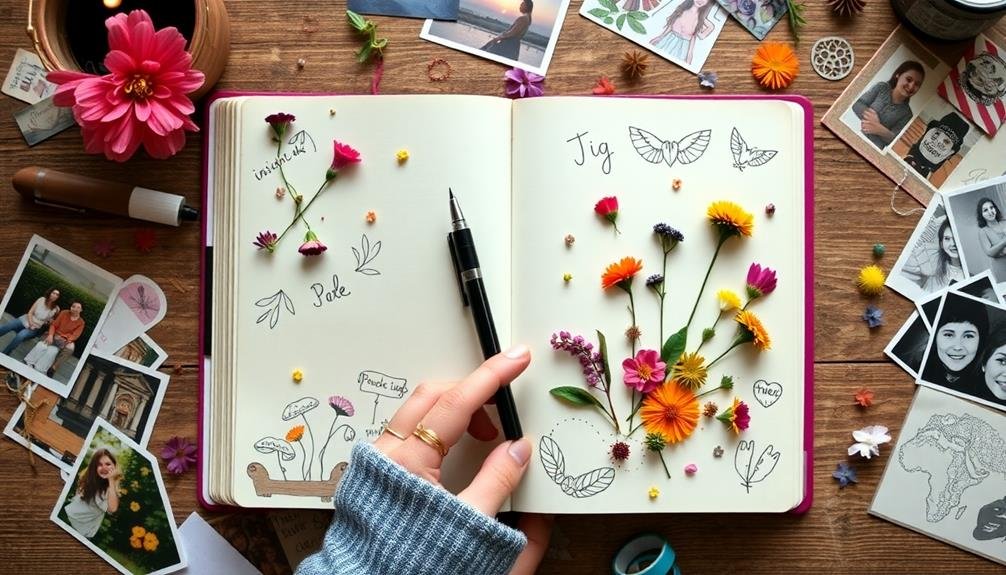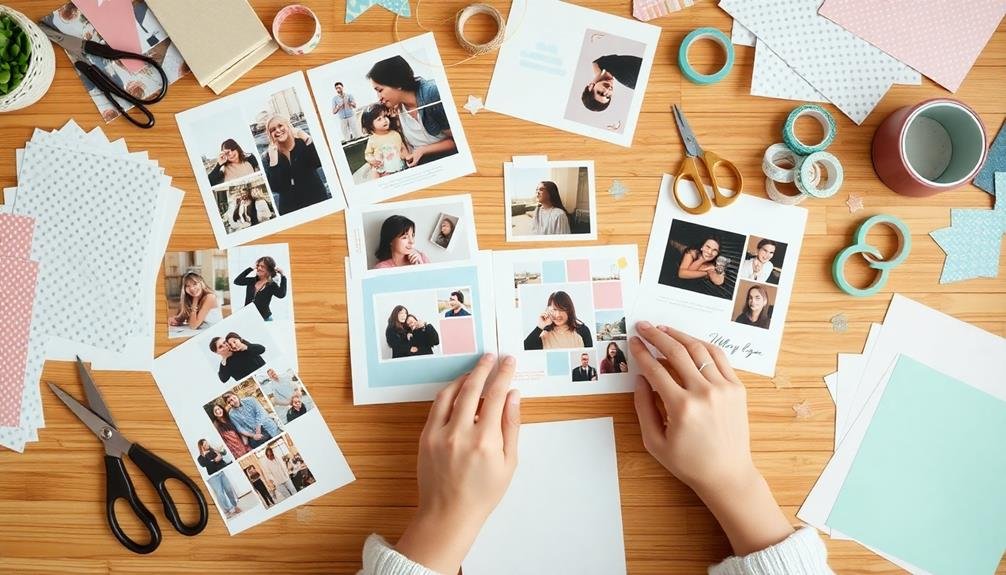Scrapbooking isn't just a creative hobby; it's a powerful tool for managing anxiety and improving your mental health. By shifting your focus to creativity, you'll engage your mind and ground yourself in the present moment. As you craft pages, you'll reframe experiences positively, preserving happy memories and building self-confidence. Choose meaningful themes, gather materials that evoke positive feelings, and incorporate journaling for deeper reflection. Use color and texture to enhance your emotional connection to each page. Establish a calming routine in a quiet space to maximize the therapeutic benefits. Discover how this tactile art form can become your personal sanctuary for emotional healing and self-discovery.
Benefits of Scrapbooking for Anxiety

Anxiety, a constant companion for many, can find a soothing adversary in the art of scrapbooking. This creative practice offers a multitude of benefits for those grappling with anxiety. As you immerse yourself in the process, you'll find your mind shifting focus from worry to creativity.
Scrapbooking provides a tactile experience that grounds you in the present moment. You'll engage multiple senses as you select papers, arrange photos, and add embellishments. This mindful activity helps calm racing thoughts and reduces stress levels.
Creating a scrapbook also allows you to reframe your experiences positively. You'll curate and preserve happy memories, giving them tangible form. This process can boost your mood and provide a valuable perspective shift during anxious times.
Moreover, scrapbooking offers a sense of accomplishment. As you complete each page, you'll experience a surge of pride and satisfaction. This feeling can counteract the self-doubt often associated with anxiety.
Lastly, scrapbooking can serve as a form of expressive therapy. You'll have a safe space to explore and process your emotions, helping you better understand and manage your anxiety over time.
Getting Started With Mindful Scrapbooking
To begin your mindful scrapbooking journey, you'll want to choose a theme that resonates with your emotions or experiences.
Select a focus that's meaningful to you, whether it's gratitude, personal growth, or cherished memories.
Next, gather materials that align with your chosen theme, including photos, mementos, and decorative elements that evoke positive feelings or reflections.
Choose Your Scrapbooking Theme
Selecting a theme for your scrapbook is an essential first step in mindful scrapbooking. Your theme will guide your creative process and help you focus on specific memories or emotions you'd like to explore.
Consider themes that resonate with your current mental state or personal growth goals. Some popular options include gratitude, self-care, personal achievements, or life changes.
Once you've chosen a theme, brainstorm related subtopics or categories. For a gratitude-themed scrapbook, you might include sections for family, friends, nature, and personal accomplishments. If you're focusing on self-care, consider pages dedicated to relaxation techniques, favorite hobbies, or inspiring quotes.
Don't feel constrained by traditional themes. You can create a scrapbook centered around your favorite color, a specific year in your life, or even abstract concepts like hope or resilience.
The key is to select a theme that sparks joy and encourages reflection.
Gather Meaningful Materials
Once you've settled on a theme, it's time to collect materials that resonate with your chosen focus. Think about items that evoke strong emotions or memories related to your theme.
Photos are often the cornerstone of scrapbooking, but don't limit yourself. Consider ticket stubs, postcards, letters, or even small objects that can be attached to your pages.
As you gather materials, focus on quality over quantity. Each item should have significance and contribute to the overall narrative you're creating.
Don't be afraid to get creative with your selections. You might include:
- Pressed flowers or leaves to represent growth or nature themes
- Fabric swatches that remind you of a specific person or place
- Handwritten notes or quotes that inspire you
Choosing Themes for Emotional Healing

Themes in scrapbooking can serve as powerful catalysts for emotional healing. When selecting themes for your mental health scrapbook, consider focusing on areas of personal growth, positive experiences, or challenges you've overcome. You might choose themes like "Self-Discovery," "Gratitude," or "Resilience" to explore different facets of your emotional journey.
For self-discovery, create pages that highlight your strengths, values, and aspirations. Include quotes, images, or mementos that reflect your evolving sense of self.
If you're working on gratitude, dedicate sections to people, experiences, or things you're thankful for. This can help shift your perspective towards positivity and appreciation.
To address resilience, document instances where you've faced adversity and emerged stronger. Use before-and-after photos, journal entries, or symbolic representations of your growth.
Don't shy away from difficult emotions; acknowledging them can be therapeutic. Consider themes like "Letting Go" or "Forgiveness" to process complex feelings.
Therapeutic Techniques in Scrapbook Design
You'll find powerful healing through thoughtful scrapbook design techniques.
Start by selecting colors that resonate with your emotions, then incorporate journaling to reflect on your experiences.
Mindful Color Selection
Colors play an important role in shaping our emotions and moods, making mindful color selection an essential aspect of therapeutic scrapbooking. When you're creating your scrapbook pages, consider how different hues can affect your mental state.
Cool colors like blues and greens often promote calmness and relaxation, while warm colors like reds and oranges can evoke energy and passion.
To practice mindful color selection, start by identifying your emotional goals for each page. Are you looking to boost your mood, find tranquility, or process complex feelings? Once you've determined your objective, choose colors that align with those intentions.
Don't be afraid to experiment with various color combinations to see what resonates with you personally.
Consider these tips for mindful color selection:
- Use color psychology to guide your choices
- Incorporate colors that remind you of positive memories or experiences
- Balance bold and muted tones to create visual harmony
Journaling for Reflection
Beyond selecting colors, incorporating journaling into your scrapbook pages can greatly enhance their therapeutic value. Journaling allows you to reflect on your experiences, emotions, and thoughts, providing a deeper level of self-expression and insight. As you create your scrapbook layout, set aside space for written reflections that complement your photos and embellishments.
Start by jotting down your initial thoughts about the memories you're preserving. Don't worry about perfection; let your words flow naturally. Consider using prompts to guide your journaling, such as "What did I learn from this experience?" or "How did this moment make me feel?" You can also explore gratitude by listing things you're thankful for related to the event or memory.
Experiment with different journaling styles. Try bullet points for quick thoughts, longer paragraphs for in-depth reflections, or even poetry to express your emotions creatively. Use your handwriting for a personal touch, or type and print your journaling if you prefer.
Sensory Texture Integration
Through the integration of sensory textures, scrapbooking can become an even more powerful tool for mental health. By incorporating various tactile elements into your pages, you're engaging multiple senses, which can enhance emotional processing and memory recall. This multisensory approach can help you better connect with your experiences and emotions.
When selecting materials for your scrapbook, consider textures that evoke specific feelings or memories. Soft fabrics might represent comfort, while rough textures could symbolize challenges you've overcome. Don't hesitate to experiment with unconventional materials like sandpaper, feathers, or even natural elements like leaves or pebbles.
To maximize the therapeutic benefits of sensory texture integration, try these techniques:
- Create a texture palette: Gather a variety of textured materials to represent different emotions.
- Use texture as storytelling: Let the feel of each element contribute to the narrative of your page.
- Practice mindful touch: Take time to explore the textures with your fingers, focusing on the sensations.
Journaling Prompts for Self-Reflection

Journaling prompts serve as powerful catalysts for self-reflection in your scrapbooking journey. They guide you to explore your thoughts, emotions, and experiences more deeply, adding meaningful context to your visual elements.
Consider incorporating these prompts into your scrapbook pages:
"What's bringing me joy right now?" This question encourages you to focus on positive aspects of your life, promoting gratitude and mindfulness.
"How have I grown in the past year?" prompts you to acknowledge personal development and celebrate progress.
"What's a challenge I've overcome?" helps you recognize your resilience and problem-solving skills.
For more introspective reflection, try "What do I need to forgive myself for?" or "What's holding me back from pursuing my dreams?"
These questions can lead to profound insights and personal growth. Don't shy away from difficult topics; they often yield the most significant breakthroughs.
Creating a Calming Scrapbooking Routine
While journaling prompts enhance self-reflection, establishing a calming scrapbooking routine can further boost your mental health benefits.
Start by designating a specific time and place for your scrapbooking sessions. Choose a quiet corner of your home where you feel comfortable and relaxed. Set up your supplies in an organized manner, making them easily accessible.
Create a ritual to signal the start of your scrapbooking time. This could be lighting a scented candle, playing soft background music, or taking a few deep breaths. As you begin, focus on the present moment and let go of any distracting thoughts.
To maintain a calming routine:
- Work on one page or section at a time to avoid feeling overwhelmed
- Take breaks when needed to stretch or hydrate
- Practice mindfulness by paying attention to the textures, colors, and sensations as you work
Frequently Asked Questions
Can Scrapbooking Be Beneficial for People With Depression?
Yes, scrapbooking can be beneficial for you if you're dealing with depression. It's a creative outlet that helps you focus on positive memories, express emotions, and practice mindfulness. You'll find it therapeutic and a great way to boost your mood.
Are There Any Age Restrictions for Therapeutic Scrapbooking?
There aren't any age restrictions for therapeutic scrapbooking. You can enjoy its benefits whether you're a child, teen, adult, or senior. It's a versatile activity that's adaptable to various skill levels and cognitive abilities.
How Long Should Each Scrapbooking Session Last for Optimal Mental Health Benefits?
You'll find ideal benefits with 30-60 minute sessions. However, it's important to listen to your needs. You can start small with 15 minutes and gradually increase. Don't force it; let your creativity and mood guide you.
Can Digital Scrapbooking Provide the Same Mental Health Benefits as Traditional Scrapbooking?
While digital scrapbooking offers some benefits, it can't fully replicate the tactile experience of traditional scrapbooking. You'll still gain creative expression and memory preservation, but you might miss out on the calming effects of hands-on crafting.
Are There Professional Therapists Who Specialize in Scrapbook Therapy?
Yes, there are therapists specializing in scrapbook therapy. You'll find professionals who incorporate this creative approach into their practice. They're often art therapists or counselors who've recognized scrapbooking's therapeutic potential. You can search online or ask local therapists for recommendations.
In Summary
You've discovered a powerful tool for managing your mental health through scrapbooking. By embracing this creative outlet, you're giving yourself space to process emotions, celebrate joys, and find calm. Remember, there's no right or wrong way to craft your journey. As you continue to explore themes, techniques, and routines that resonate with you, you'll build a personalized practice that supports your well-being. Keep creating, reflecting, and growing – your scrapbook is a reflection of your resilience and self-discovery.





Leave a Reply